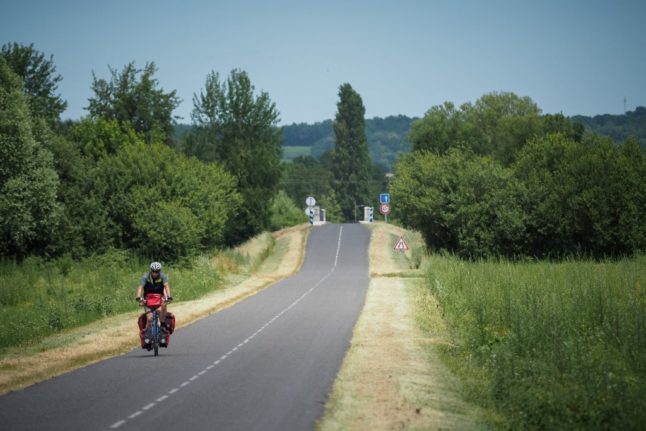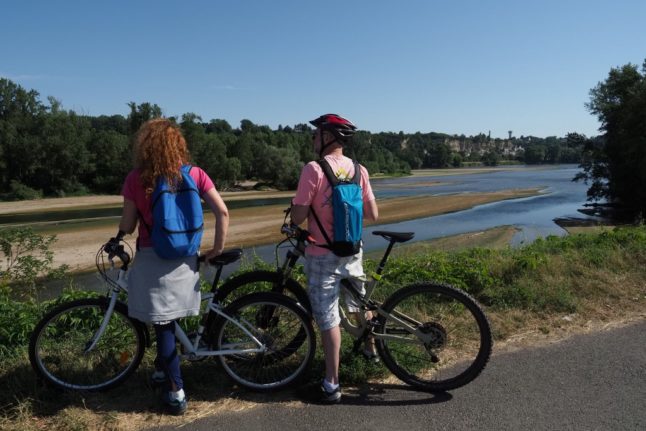The rate of dedicated cycle paths in France being built and expanded upon is ever increasing. More towns are looking to reap in the benefits which separated cycling infrastructure can bring. In many areas they stand in places where a rail line used to be. This often means they also provide you with a relatively flat cycling route.
Whilst it is common to find these cycle paths built alongside canals and rivers, there are also some to explore in mountainous regions too. We definitely recommend seeking these out in the Alps and Pyrenees. Greenways in the mountains are are a great way to get an easier ride in, resting those legs and avoiding steep gradients.
Here are seven of the best that we have ridden so far:

1 Lourdes – Voie Verte des Gaves – 17.5km each way
Located in the Pyrenees, this greenway takes advantage of the disused railway line which used to run all the way to Cauterets. Now the tracks have been paved and you can enjoy a pedal along the valley floor away from the busier tourist town of Lourdes.
The ride will see you take in 10 smaller villages to the start of the Gorge de Luz. Check here for a full write-up of this route in our Pyrenees section.
It is possible to continue on from the end point at Pierefitte Nestalis all the way to Cauterets on a dirt track. If you do this you’ll need to be on a bike with wider tires to accommodate the rockier terrain.
View the route HERE
2 Annecy – Lake Annecy cycle trail to Albertville 45km each way
This trail travels along the eastern shoreline of Lake Annecy connecting it up almost all the way to the town of Albertville.
Travelling alongside the turquoise waters of the lake, you will roll through a disused rail tunnel and then pedal your way through the countryside, all the while being able to look up at the giant Alpine mountains looming overhead. In fact at some points you even have great vistas of Mont Blanc itself.
At present the trail finishes 5km prior to reaching Albertville but work is also underway to complete the trail around the entire perimeter of Lake Annecy.
View the route HERE
3 Dordogne – Sarlat to Cazoules Voie Verte – 25km each way
This was the very first ride we ever did on our first trip to France. The route follows the disused rail way line from the picturesque medieval town of Sarlat la Caneda to Cazoules.
It includes a very long old rail tunnel and also includes a bridge crossing of the magnificent Dordogne river. We both enjoyed this as a great introduction to the charm of riding in France. Passing old villages, spotting crumbling chateaux up on the cliffs above, you can’t help but be transported back centuries in time.
View the route HERE
4 Bordeaux – Roger Lapebie Voie Verte – 57km each way
This trail starts in the beautiful city of Bordeaux in southwest France and travels all the way to Sauveterre-de-Guyenne.
We actually rode this greenway using the Bordeaux VCub city bike scheme. The trail begins with a bridge crossing of the Garonne river. From there the cycle path winds its way alongside the river, taking you through small quaint villages.
You will also ride past some of the wineries which make the region famous. The gradient is almost entirely flat and suitable for all fitness levels.
View the route HERE
5 Piste Cyclables – Île de Ré – 98km
The island of Île de Ré sits just off La Rochelle on the Atlantic coast. Linked to La Rochelle by a huge 3km bridge (which has a fully separate cycle lane!) the small island is best explored on two wheels. There are almost 100km of cycle tracks to ride on and apart from the slight gradient of the bridge itself the terrain is completely flat.
We thoroughly enjoyed spending half a day on these cycle paths, riding past old monuments, villages and forts. Stunning views of the vast Atlantic ocean were also a constant.
View the route HERE
6 Canal du Midi – Toulouse -Etang de Thau 240 km
The Canal du Midi was first constructed in 1666 with the aim of providing a water link between the Garonne River and the the Mediterranean Sea. To ride the entire section of the canal would make a fantastic cycling holiday in itself, but on a weekend spent in Toulouse we decided to hire some of the city bikes and enjoyed a great cycle along the canal.
With vast sections lined with impressive plane trees, riding here is very pleasant and would be a dream in summertime with the shade they would provide.
We certainly want to come back and ride the whole canal at some stage. If you are after a bigger challenge holiday it is possible to ride an even longer route called the Canal des Deux Mers. This route links the Atlantic Ocean with the Mediterranean Sea.
View the route HERE
7 Via Rhona – Geneva to Marseille
The Via Rhona is a vast cycling route linking sections of separated cycling greenways with quieter back roads.
The route runs from Geneva to Marseille, traversing through the larger cities of Lyon and Valence along the way. It is very well signposted and there are many options to create a multi-day cycling tour if you so wish. We have really enjoyed riding separate sections of this route such as the southern side of Lake Geneva as well as along the Rhone river in France.
View the route HERE
So there you have it, 7 cycle paths to add to your list of places to ride in France. We are sure you will enjoy riding them as much as we have.

Bella Molloy runs the Seek Travel Ride travel site dedicated to cycling in France. She fell in love with the country after her first holiday on two wheels in 2013 and since then returns regularly (pandemic travel rules permitting) to explore new areas of the country and its cycle routes. Find more of her work at www.seektravelride.com



 Please whitelist us to continue reading.
Please whitelist us to continue reading.
Member comments